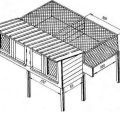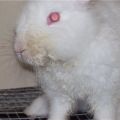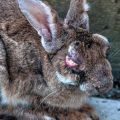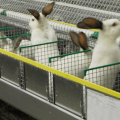Symptoms and treatment of worms in rabbits, the best medicines and prevention
Insidious parasites are a real disaster for owners of eared pets. The problem threatens farmers with big losses, because the quality of future products is under attack. With the help of a veterinarian, hosts can early determine if rabbits have worms, see symptoms, and begin treatment. Timely preventive measures will help to avoid troubles.
How does infection occur
Even in good conditions, animals run the risk of becoming prey for worms. Most often, infection occurs while feeding pets. Together with hay, rabbits eat helminth eggs, which are abundant in dry grass. Once in the animal's esophagus, the parasites emerge from the eggs and begin to grow. Having reached maturity, the formed worms affect the pet's body. The initial stage of infection goes unnoticed by the host. The behavior and appearance of the fluffy pet do not change, the rabbit is still cheerful and eagerly eats food.
Problems begin later, when the number of parasites in the pet's body increases many times over. The pet is rapidly losing weight and beauty of the skin. Most often, trouble happens with rabbits living in unsanitary conditions, when animals are kept in a dirty cage, on an earthen floor. Parasites easily enter the pet's home through small domestic animals.
Chickens, ducks, cats or dogs with helminthiasis can infect a rabbit. It costs nothing for the tiny parasites to move to the rabbit feeder or bedding. If the pet lives in good conditions and eats well, it can avoid the severe consequences of infection. A strong, healthy animal has strong immunity and a healthy gastrointestinal tract. Parasite eggs, as a rule, die in an acidic gastric environment.
To a greater extent, rabbits are exposed to misfortunes. They have not yet had time to strengthen the immune system and develop an acidic environment in the stomach. Babies have a harder time than adults. Worms destroy the baby's fragile immune system. If the parasites reach a large number, they go into a ball and, like a cork, clog the intestines of the animal. This can result in intestinal rupture and the death of the rabbit.
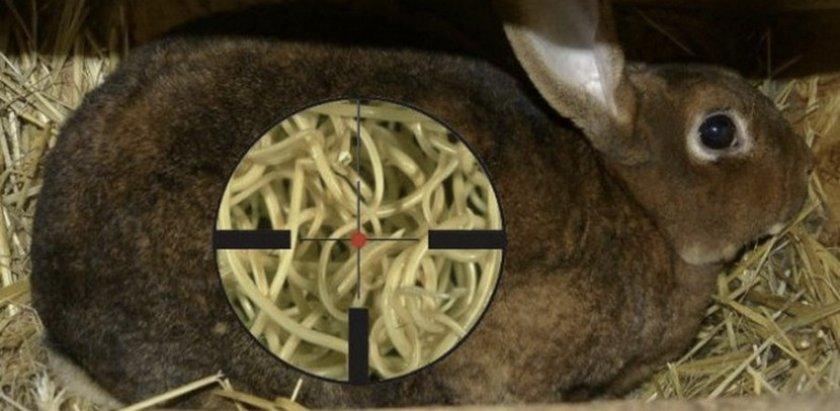
For an adult rabbit, helminthiasis is a lot of trouble. As a result of infection, the animal's immunity is noticeably weakened. In advanced cases, parasites destroy the protective mucous membrane of the pet's stomach. From this point on, dangerous bacteria can freely enter the animal's circulatory system. As a result, the pet's body can no longer withstand diseases.Any accidental infection combined with helminths can lead to a sad outcome.
Symptoms of helminthiasis
Parasites seize the victim's body gradually, so it is not easy to recognize the danger in time. Alarming symptoms indicate the infection of an eared pet with helminths:
- The animal displays an irrepressible appetite, but the animal's weight is greatly reduced.
- Pet every now and then greedily drinks water.
- The animal sheds heavily. If untreated, the number of parasites increases and molt becomes more intense.
- The rabbit gradually develops diarrhea or vice versa - constipation. An admixture of greens is visible in the excrement.
- The anal area becomes inflamed and becomes reddish.
- In some cases, the pet refuses food, sits indifferently in the corner of the cage and does not respond to touch.

Methods for diagnosing invasion
For an accurate diagnosis, you need to take a pet's blood for analysis. In the course of their vital activity, parasites release a large amount of specific toxins. These substances affect the composition of the animal's blood, so the analysis provides accurate information about the infection. The study of feces is informative only at the moment when the worms have already safely settled in the animal's body. However, if the parasites are in the rabbit's esophagus in the egg stage, the analysis will show nothing.
In an advanced case, the parasites can be seen with the naked eye. To do this, you need to carefully consider the pet's feces. During the period of active reproduction, pinworms lay a huge number of eggs, they are clearly visible in the form of white blotches.
What types of worms do breeders encounter in rabbits:
- Pinworms. Helminths enter the body of pets with food. Rabbits and hares become victims of infection. As a result of the spread of worms, animals fall ill with passalurosis. Parasites cause unbearable itching in rabbits. The exhausted animal constantly rubs against the bars of the cage or on the floor. Worms are not only dangerous for pets. Parasites are easily transmitted to humans, causing an unpleasant disease of enterobiasis.
- Parasites are echinococcus. Like pinworms, helminths enter the rabbit's body through food. This is where the similarities between the parasites end. Echinococcus uses the animal as an intermediate base. The larvae of the worms find refuge in the liver and other organs of the rabbit. Tumors are formed in the places of dislocation of echinococci. A sick animal does not pose a danger to its relatives.
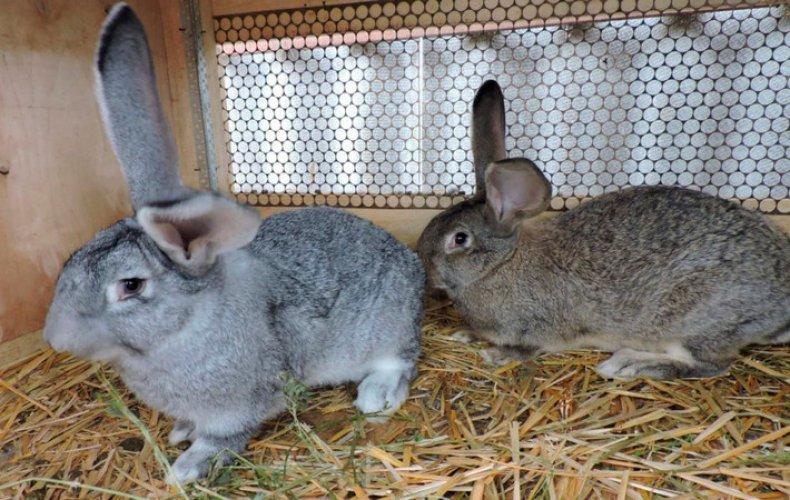
Methods for treating worms in rabbits
Even with full confidence in the cause of the disease, self-medication is unacceptable. All drugs are given after a veterinarian's prescription. You need to study the instructions and calculate the dosage of the medicine.
Medicines
For the treatment of helminthiasis, animals are given an anthelmintic. For eared beauties, there are effective and safe drugs:
- "Shustrik" is a broad-spectrum drug, made in the form of a suspension. This gentle product is added to water or pet food.
- Albendazole. The tool is used in case of damage to the internal organs of the animal with lamblia and nematodes. Deworming is carried out simultaneously with the intake of immuno-strengthening drugs.
- "Gamavit" is an excellent remedy for strengthening a pet's shaky immunity.
- Levamisole. This drug successfully copes with the destruction of nematodes and worms. For eared patients "Levamisole" is used in the form of a 10% solution. The drug is administered to the rabbit by injection.The remedy is contraindicated in pregnant females, weakened individuals and rabbits younger than 4 months.
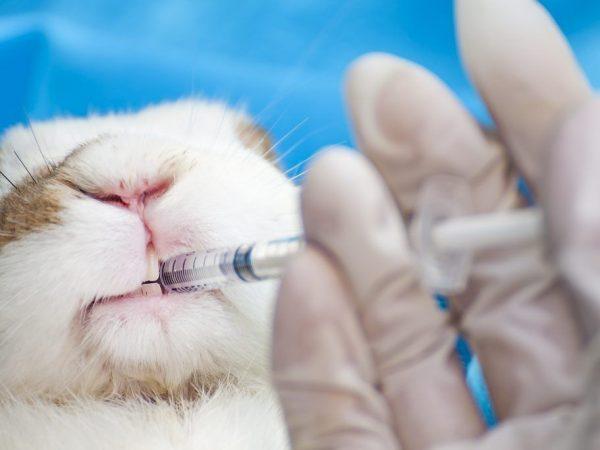
For the treatment of pinworms, the anthelmintic agent "Sulfate-piperazine" is also used. Before the course of treatment, preliminary preparation of the pet is carried out - the animal is not fed during the day. The medicine is given at the rate of 1.5 g of the drug per 1 kg of weight.
If the pet is fragile, weak, you can carry out a gentle treatment, but in this case, you will have to spend more time on the course. For this, "Phenothiazine" is used. Dosage of the drug: 0.1 g per 1 kg of pet's weight. Suspension "Shustrik" or "Albendazole" is also suitable for infected rabbits. In case of infection of an animal with echinococcus, the drug "Mebendazole" is used. For a handsome eared man, the dose of the drug is calculated by the formula: 5 mg per 1 kg of weight. The course of treatment is designed for 5 days.
Folk methods and recipes
When treating broiler animals, one has to take into account that chemical preparations will inevitably affect the composition and quality of meat, so farmers often resort to folk remedies to combat parasites. In order for the helminths to leave the pet's body, you need to drink the animal with a decoction of medicinal herbs or give the rabbit a medicine along with food.
- Tansy. The plant is widely known and even received a second name - worm. The natural medicine is mixed with the main food. The plant is used carefully, the daily rate of the natural remedy should not exceed 2 branches. Tansy is known for its astringent properties, therefore, excessive enthusiasm for aromatic medicine threatens the animal with constipation.
- Pumpkin. The remedy is traditionally considered the best way to get rid of parasites. The seeds of an orange vegetable are fed to rabbits in small portions.
- Sagebrush. Thunderstorm pinworms and roundworms. The herb is added to the general diet. Wormwood should make up 30% of the total amount of food. For the treatment of rabbits, the dose of the drug is reduced.
- The needles not only successfully fight different types of helminths, but also enrich the pet's body with vitamins. An arbitrary amount of needles is mixed into a portion of hay. A natural medicine is harvested in winter, at temperatures no higher than 20 degrees below zero. The essential oils found in conifers are dangerous for eared pets. After the onset of frost, the concentration of the odorous substance decreases, and the needles can be safely used to treat rabbits. Otherwise, the animals can be poisoned and die.

Prevention of helminthiasis
Compliance with some rules will help reduce the risk of disease in animals. All rabbits are periodically given anthelmintics. Exceptions are made only for rabbits under 3 months of age. Rabbits must be treated before giving birth. This is important because parasites can be passed on to offspring and ruin all droppings. Before vaccination, animals must be treated for worms. The interval between the last dose of the drug and the vaccination is at least 14 days.
In addition, it is necessary to clean the cage in time, remove the waste products of the rabbits. It is forbidden to harvest grass for forage in secluded, swampy places. Dangerous for mowing grass and meadows where traces of hares have been seen. These wild relatives serve as carriers of helminths. If there are dogs on the farm, they are kept away from rabbits. Psam periodically give anthelmintics. When caring for a sick animal, you need to take precautions, because some types of parasites are dangerous to humans.

Is it possible to eat rabbit meat with worms
Ministry of Health officials allow the use of meat contaminated with helminths after special processing. Before cooking, the product is deep-frozen or cooked for a long time.
However, veterinarians adhere to a different point of view and categorically prohibit the consumption of contaminated meat for food. In any case, there are few people who want to taste such a delicacy. It is unpleasant to realize that disgusting worms have recently swarmed in a tender piece of meat.



